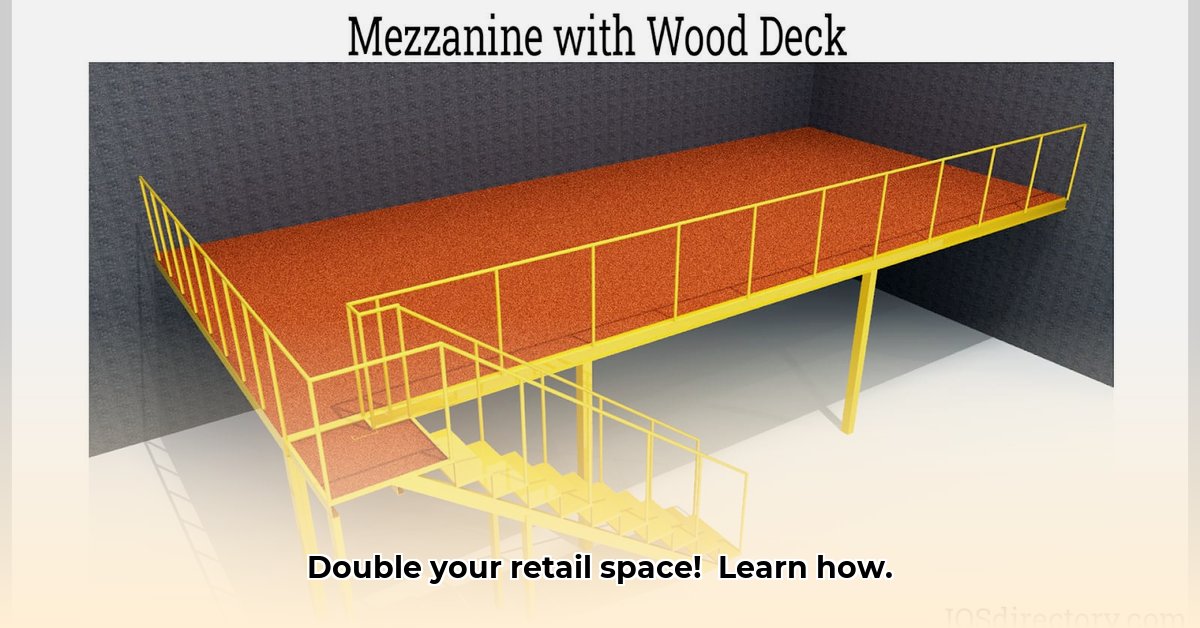Rent too high? Running out of room in your store? A mezzanine floor might be your answer! This comprehensive guide shows you exactly how to add a second level to your retail space, step by step. We’ll cover everything from initial planning and design to navigating building codes, finding the right contractor, and ensuring its long-term success. Think of it as adding a whole new floor to your business without the hassle and expense of moving. We’ll show you how to make it look great, function perfectly, and boost your bottom line. For more in-depth guidance, check out this [mezzanine installation guide](https://www.wavesold.com/mezzanine-floor-installation-guide). Let’s get started and unlock the extra space you need to thrive!
Mezzanine Floor for Retail: Unlocking Your Store’s Hidden Potential Through Strategic Space Optimization
Considering expanding your retail space without the exorbitant costs and disruptions of relocation or traditional construction? A mezzanine floor offers a compelling solution. This detailed guide breaks down everything you need to know about adding this valuable extra level to your store, from initial planning and design considerations to long-term maintenance and structural integrity.
Planning and Designing Retail Mezzanines: Laying the Groundwork for Future Growth and Increased Product Display
Before diving into construction, meticulous planning is paramount. Think of it as tailoring a bespoke suit – precision is key! Begin by thoroughly evaluating your existing store layout. Identify underutilized vertical space. Where could additional square footage provide the greatest benefit? This assessment will inform your mezzanine’s ideal size, placement, and intended use, whether for expanded product displays, storage, or even a small cafe area.
Next, harmonize the mezzanine’s design with your store’s branding and aesthetic. Consider shelving solutions and display options that maximize space and visual appeal. The mezzanine should seamlessly integrate with your existing style, either blending in or serving as a striking design statement. Carefully consider materials: wood, steel, composite materials, or a combination?
Visualize the customer journey. How does the addition of the new level impact shopper flow and overall experience? Will it feel cramped or confusing, or will it enhance navigation and discovery? Clear sightlines are important. These questions are crucial for creating a cohesive and inviting customer experience. Consider incorporating elements like glass railings to maintain an open feel.
- Mezzanine installations can significantly increase usable retail space, often doubling it without altering the building’s footprint.
- Careful planning, adherence to local building codes, and selection of appropriate materials are crucial for success and safety.
- Choosing a qualified and experienced contractor ensures code compliance and mitigates potential risks.
Legally, you’ll need to obtain the necessary permits from your local building department. This process involves navigating and complying with building codes related to height restrictions, fire safety regulations, load-bearing capacity, and accessibility requirements. Start this process early to prevent delays and avoid potentially expensive issues down the road. Engage with local building officials early in the planning process.
Navigating Building Codes and Regulations: Ensuring Safety and Compliance
Building codes exist to ensure the safety and structural integrity of your mezzanine. Key aspects to consider include:
- Headroom Clearance: Building codes mandate a minimum vertical clearance, typically around 7 feet, both above and below the mezzanine floor. This ensures comfortable movement and prevents accidental head injuries.
- Mezzanine Area Restrictions: To prevent overcrowding and maintain adequate ventilation, regulations often limit the mezzanine’s footprint to a certain percentage of the total floor area below. This percentage can vary depending on local codes.
- Emergency Exits: Just like any other floor, your mezzanine must have clearly designated and accessible emergency exits that meet building code requirements for width, signage, and fire-resistance ratings.
- Load-Bearing Capacity: The mezzanine must be designed to safely support the anticipated weight of people, merchandise, and equipment. A structural engineer can assess your existing floor and determine the necessary specifications.
- Fire Safety: Fire-resistant materials, sprinkler systems, and appropriate fire extinguishers may be required to ensure the safety of occupants in the event of a fire.
- Accessibility: Depending on the size and use of your mezzanine, you may need to comply with accessibility requirements, such as installing ramps or elevators to accommodate customers with disabilities.
Remember, building codes can vary significantly depending on your specific location, so it’s crucial to consult with your local building authority or a qualified architect or structural engineer to ensure full compliance.
Choosing the Right Contractor: Finding Your Perfect Building Partner for a Successful Project
This is not the time to cut corners or opt for the cheapest option. Selecting the right contractor is essential for a smooth and successful mezzanine installation. You’re investing in your business’s future, so prioritize expertise and reliability over rock-bottom pricing.
Thoroughly research potential contractors. Verify their licenses, insurance coverage (including worker’s compensation and liability), and, most importantly, their experience with retail mezzanine installations. Request references from previous clients and take the time to contact them and inquire about their experience with the contractor. Look for a proven track record of successful projects and satisfied customers.
Ask detailed questions about their proposed approach, project management style, and quality control procedures. Get everything in writing, including a detailed scope of work, project timeline, payment schedule, and warranty information. A well-defined contract protects both you and the contractor and minimizes the risk of misunderstandings or disputes.
The Mezzanine Installation Process: A Step-by-Step Overview of Retail Space Construction
Building a mezzanine is not a DIY project. It’s a complex undertaking that requires specialized skills and equipment. Here’s a simplified breakdown of the typical installation process:
- Site Preparation: The construction area needs to be prepared for the installation. This may involve removing existing fixtures, equipment, or inventory, and reinforcing the existing floor to ensure it can support the additional weight of the mezzanine.
- Steel Framework Construction: The mezzanine’s steel frame serves as its structural backbone. It’s precisely fabricated and securely fastened to the existing building structure. This step requires meticulous attention to detail and adherence to engineering specifications to ensure stability and safety.
- Flooring Installation: Once the steel framework is in place, the flooring is installed. Options range from durable plywood and oriented strand board (OSB) to composite materials and even concrete, depending on your budget, intended use, and aesthetic preferences.
- Stair and Railing Installation: Safe and accessible stairs and railings are essential for any mezzanine. Building codes dictate specific requirements for stair width, rise, run, and railing height.
- Finishing Touches: This is where your vision truly comes to life. This phase includes installing lighting fixtures, electrical wiring, and any desired cosmetic finishes, such as paint, flooring coverings, or decorative elements.
Post-Installation: Maintenance and Ongoing Care for Long-Term Success and Code Compliance
Your new mezzanine is not a “set it and forget it” addition to your store. Regular maintenance is crucial for preserving its structural integrity, ensuring the safety of occupants, and maintaining compliance with building codes. Think of it as regular check-ups for your car – preventive care can extend its lifespan and prevent costly repairs down the road.
Schedule regular inspections to identify and address any signs of wear and tear, such as loose bolts, damaged flooring, or corroded metal. Promptly repair any minor damage to prevent it from escalating into more significant problems. Address any potential safety hazards immediately.
As your business evolves, you may need to adapt the mezzanine to meet changing needs. This may involve rearranging the layout, upgrading the lighting, or even making structural modifications. Consult with a qualified contractor or engineer to ensure that any modifications comply with building codes and do not compromise the safety or integrity of the mezzanine.
Real-World Examples: Boosting Sales and Efficiency with Strategic Mezzanine Implementation
- Bookstore Transformation: Imagine a bookstore struggling with limited shelf space and cramped aisles. By installing a mezzanine, they created a spacious second-level display area for rare books and special editions, significantly increasing their inventory capacity and creating a visually appealing and unique shopping experience. The result was increased sales and a more loyal customer base.
- Boutique Expansion: One local boutique successfully installed a mezzanine, effectively doubling their display space for clothing and accessories. This allowed them to showcase a wider range of products and create more visually appealing displays. The result was a significant increase in sales within six months.
- Warehouse Optimization: A small online retailer utilized a mezzanine to create a dedicated packing and shipping area within their existing warehouse space. This streamlined their order fulfillment process, reduced shipping times, and improved overall efficiency.
Weighing the Pros and Cons: Determining if a Mezzanine is the Right Choice for Your Business
Let’s be realistic: every solution has both advantages and disadvantages. Carefully consider the following pros and cons to determine if a mezzanine is the right fit for your specific needs and circumstances:
| Pros | Cons |
|---|---|
| Significant increase in usable floor space | Potential reduction in ceiling height |
| Cost-effective expansion option compared to relocation | Possible noise transmission between levels |
| Improved workflow and optimized storage solutions | Requires thorough planning and expert execution |
| Enhanced product display and customer experience | May slightly alter the aesthetics of the store |
| Increased property value | Can be disruptive to business during installation |
Conclusion: Taking the Leap with Confidence and Planning
A well-planned and professionally installed mezzanine can be a game-changer for your retail business, providing a cost-effective way to expand your usable floor space, improve workflow, and enhance the customer experience. It’s an investment with the potential for significant long-term returns
- Glass Tile Shower Ideas to Create a Stunning Bathroom Space - December 7, 2025
- Glass Wall Tile Ideas for Kitchens and Bathrooms - December 6, 2025
- Glass Tile Bathroom: Create a Beautiful, Easy-Clean Space - December 5, 2025










